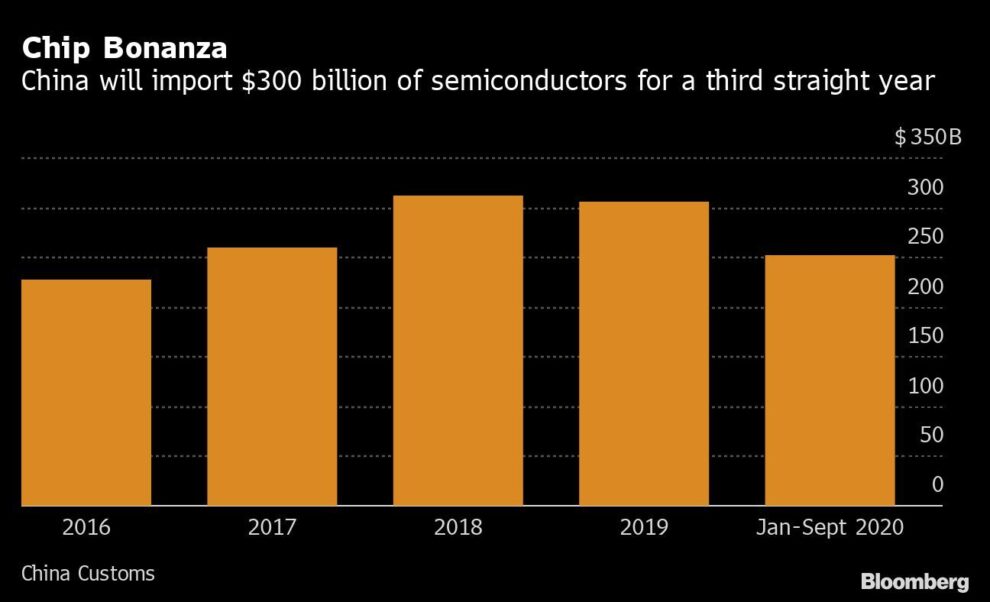
(Bloomberg) —
In just two decades, China sent people into space, built its own aircraft carrier and developed a stealth fighter jet. Now the world’s youngest superpower is setting out to prove its capabilities once more — this time in semiconductors.
At stake is nothing less than the future of the world’s No. 2 economy. Beijing’s blueprint for chip supremacy is enshrined in a five-year economic vision to be unveiled during a summit of top leaders in the capital this week. It’s a multi-layered strategy both pragmatic and ambitious in scope, embracing aspirations to replace pivotal U.S. suppliers and fend off Washington, while molding homegrown champions in emergent technologies.
China wants to build a coterie of technology giants that can stand shoulder-to-shoulder with Intel Corp. and Taiwan Semiconductor Manufacturing Co., conferring the same priority on that effort as it accorded to building atomic capability. While specifics of that endeavor won’t emerge for months, comments by government officials, Party mouthpieces like the People’s Daily and state think-tanks provide important clues about the envisioned road map.
Read more: Xi Mobilizes China for Tech Revolution to Cut Dependence on West
The approach entails making do over the next five years or so with aging semiconductors that are adequate for electric cars and even military applications, but can’t run advanced smartphones and similar devices. That buys China time to focus on fields like so-called third-generation chipmaking in which no country yet dominates and — Beijing hopes — create an array of indigenous giants in areas including machinery, software and new materials. The ultimate goal is to groom local alternatives to global linchpins like Cadence Inc. and Synopsys Inc. in design software and Europe’s ASML Holding NV in chipmaking gear.
“Semiconductors are a crucial sector in the information era that will lead the future of economic development,” Science & Technology Minister Wang Zhigang said at a press conference last week. “At the same time, China will strive to achieve self reliance and strengthen our own capabilities.”
The World Is Short of Computer Chips. Here’s Why: QuickTake
China’s efforts gained urgency because the Biden administration is escalating a battle against what it called “techno-autocracies.” That could extend or even expand blacklistings that banned key transactions with corporations from Huawei Technologies Co. to ByteDance Ltd. and Tencent Holdings Ltd. To a country that imports $300 billion of chips annually, a worsening global shortage drives home the risk of relying on potentially hostile suppliers for the building blocks of everything from artificial intelligence to sixth-generation networking and autonomous vehicles.
It will take years for local companies to match foreign counterparts in manufacturing and design expertise, during which there’s no ready answer to the dominance of Japanese and American names in chipmaking equipment. Chinese companies will still only supply 35% of its domestic demand by the end of this decade, IDC analyst Mario Morales estimates.
They’ll also have to contend with Washington. The U.S. signaled it intends to go ahead with a Trump administration-proposed rule to secure the technology supply chain next month, a move that gives the Department of Commerce broad authority to prohibit transactions involving “foreign adversaries” like China.
“The United States and its allies should utilize targeted export controls on high-end semiconductor manufacturing equipment … to protect existing technical advantages and slow the advancement of China’s semiconductor industry,” the National Security Commission on Artificial Intelligence, headed up by former Google chairman Eric Schmidt, recommended to Biden and Congress this week.
Huawei, the country’s largest technology company by revenue, underscores the leverage Washington wields. Once the world’s biggest smartphone maker, Huawei was forced to sell its Honor division and run at close to minimum production capacity after it lost access to chips from the likes of TSMC under American regulations.
Read more: China Said to Plan Broad Chip Sector Support to Fight Trump
“It just stimulates the Chinese community to accelerate their internal developments and eventually they may come out even stronger,” said Luc Van den hove, president of the Imec research center in Leuven, Belgium, which focuses on innovation in semiconductor technology. “And I think that’s certainly a risk of trying to keep the two worlds further apart.”
Read more: Biden Putting Tech, Not Troops, at Center of U.S.-China Strategy
Beijing had set aside at the start of its last five-year plan around 1 trillion yuan ($155 billion) for potential investment in semiconductors over five to 10 years, according to McKinsey. It will now continue to bankroll research and investment in coming years, Wang said last week. That should galvanize the much larger influx of private capital needed to produce genuine breakthroughs.
It’s an approach that’s worked before for the internet, where a mix of government and private capital helped build the likes of Alibaba Group Holding Ltd. and ride-hailing giant Didi Chuxing Inc. In February, the state-backed Global Times reported smartphone makers Xiaomi Corp. and Oppo acquired stakes in Jiangsu Changjing Electronics Technology Co., exemplifying the sort of private-sector involvement Beijing’s counting on.
When it comes to the chips, “we will see more support relative to private firms, because they play a bigger role in those sectors,” said Wendy Leutert, GLP-Ming Z. Mei Chair of Chinese Economics and Trade at Indiana University.
Read more: The U.S.-China Conflict Over Chips Is About to Get Uglier
In the meantime, up-and-comers such as Semiconductor Manufacturing International Corp. and Tsinghua Unigroup can help tide the country over a deficit of mobile processors, memory and telecom modules should Washington close off supply routes. They will mainly operate mature processes of 14 nanometers and older, sufficient for all but the most exacting applications such as smartphones, high-performance computing and graphics processors. Meanwhile, global leader TSMC is ramping up for mass production of 3 nm chips in 2022, about five or six generations ahead.
At the same time, they’ll act as focal points for the country’s most capable brains to work on stop-gap measures such as advanced packaging that can improve chip computing power in the absence of more sophisticated U.S. technology. The hope is that such fine-tuning buys time for the homegrown development of advanced technologies, such as in 7-nanometer chips and silicon design software.
Some of the key local players in that space include Shanghai Micro Electronics Equipment Co. and Naura Technology Group Co., who are working on equipment that can someday replace ASML’s extreme ultra-violet lithography or EUV machines — a prerequisite for any advanced chipmaking.
Local startups like Empyrean are trying to replicate the similarly indispensable software tools licensed by Synopsys and Cadence, employed by most of the world’s chip designers from Intel on down. Even in the commoditized realm of memory, a subsidiary of state-backed Tsinghua Unigroup is spending billions on mass production to challenge Samsung Electronics Co. and Micron Technology Inc.
What Bloomberg Intelligence Says
TSMC may lose market share in China in the next three years to local contract chipmakers such as Semiconductor Manufacturing International. These Chinese peers are accelerating advance-node technology development and will likely gain orders from local chip designers such as Will Semiconductor and Unisoc, which are trying to avoid dependence on U.S. technology due to bilateral trade tensions and the risk of sanctions.
– Charles Shum and Masahiro Wakasugi, analysts
Click here for the research.
Read more: China Still Buying $300 Billion of Chips From U.S., Elsewhere
President Xi Jinping has pledged an estimated $1.4 trillion through 2025 for technologies ranging from wireless networks to AI. A big chunk of that is geared toward semiconductors.
Chinese firms such as Tsinghua will be responsible for building half the world’s 30-odd new fabrication plants or fabs in the next two years alone. It’s already spending 2.4 times more than the U.S. on semiconductor equipment, much of it made by American companies, Morales wrote in a report.
The World Is Short of Computer Chips. Here’s Why: QuickTake
The bet is that its corporations can compete if they accelerate research into burgeoning, adjacent fields like AI and quantum computing now. That’s where third-generation chips come in. Those are mainly made of materials such as silicon carbide and gallium nitride, can operate at high frequency and in higher power and temperature environments, with broad applications in fifth-generation radio frequency chips, military-grade radar and electric vehicles.
The country may secure first-mover advantage, even if traditional silicon-based semiconductors will continue to account for the vast majority of global use for the foreseeable future, Citigroup analysts have said. U.S.-based Cree Inc. and Japan’s Sumitomo Electric Industries Ltd. are just beginning to grow this business, while Chinese rivals such as Sanan Optoelectronics Co. and state-owned China Electronics Technology Group Corp. have made inroads.
The country’s other chipmakers, which include SMIC, Will Semiconductor Ltd. and National Silicon Industry Group Co., benefit more broadly from the state support.
“The investment commitment that China is making ensures that the Chinese semiconductor ecosystem will continue to play an important role in the progress of our industry and the overall IT market,” said IDC’s Morales.
For more articles like this, please visit us at bloomberg.com
Subscribe now to stay ahead with the most trusted business news source.
©2021 Bloomberg L.P.





